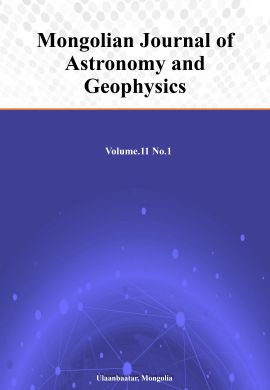The relationship between geological features and phase tensor: examples from Mogod an Tsenker study areas
DOI:
https://doi.org/10.5564/mjag.v11i1.4191Keywords:
Impedance tensor, Faults, geoelectric structure, inversionAbstract
The magnetotelluric phase tensor contains information about the directionality and dimensionality of the study region’s geo-electrical structure. In this context, the phase tensor controls geological faults or fractured zones and homogeneities of the lithology. Although the phase tensor is commonly used for magnetotelluric analysis, it is still poorly introduced in Mongolian case studies. Therefore, this paper introduces the theoretical concepts of the phase tensors and their applications in the Tsenkher and Mogod geothermal regions. For this study, we used magnetotelluric data sets from the previously conducted measurements in 2019 and 2022 at the Tsenkher region and newly measured data at the Mogod region in 2024. With this study, we re-analyzed all observed data with advanced approaches to improve data quality, resulting in smooth and clean magnetotelluric impedance tensors being obtained. The impedance tensors were used to estimate the real-valued distortion-free phase tensor at every unique measurement site. We calculate the geo-electrical strike direction from the phase tensor with the Swift angles at every site and dimensionality. As a result, the phase tensors represented the geo-electrical direction and dimension that indicates geological faults and the voluminousness of the massive rocks. Another advantage of this study is providing a developed MATLAB-based code to calculate and plot the phase tensor as a tool to support geoscientists for their future study. In the end, based on the implementation of this research, we conclude that magnetotelluric phase tensor could be used as an efficient tool for geological interpretation for geoscientific studies in the country.
Downloads
245
Downloads
Published
How to Cite
Issue
Section
License
Copyright (c) 2024 Enkhzul Bayartogtokh, Batmagnai Erdenechimeg

This work is licensed under a Creative Commons Attribution 4.0 International License.
Copyright on any research article in the Mongolian Journal of Astronomy and Geophysics is retained by the author(s).
The authors grant the Mongolian Journal of Astronomy and Geophysics a license to publish the article and identify itself as the original publisher.

Articles in the Mongolian Journal of Astronomy and Geophysics are Open Access articles published under a Creative Commons Attribution 4.0 International License CC BY.
This license permits use, distribution and reproduction in any medium, provided the original work is properly cited.




